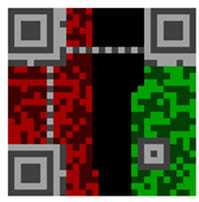QR Codes are being used more and more in magazines and on billboards.
They offer a good bridge between the real world and the digital world of the internet. Scanning a QR Code that contains an URL avoids typing errors and even deep-linking into your website becomes easier. Another benefit is the trace-ability of the code usage, offering various statistical information on the scanned QR Code.
There is only one big drawback in QR Code usage, at first glance all QR Code’s look the same. Various companies jumped into this market by making Custom QR Code. Just image-Google “custom qr codes” and a lot of graphical enhanced QR Codes are displayed.
How is it possible to change the appearance of the QR Code and still keep a working scan-able code? The information in a QR Code is build up in a combination of a message and error correction. The error correction information can detect and repair a number of errors of the scanned message. This could be the errors that have been introduced by changing the graphical appearance of the QR Code.
This type of QR Code enhancement has a drawback; the graphical change could introduce too many errors rendering the QR Code unusable.
Time to investigate and developed a new approach.
As stated the content of a QR Code is a message part and an error correction part. The total size of these parts is fixed within the QR Code specification. Mostly the message part of the content is not completely filled with actual data, but also contains padding to get the required message length.
The picture illustrates a typical QR Code:
• The gray section is to identify a QR Code.
• The green is the used and the black is the unused (padded) message area.
• The red is the error correction information.
When the content is an URL, shortened by online engines like goo.gl or bit.ly about the half or the message is not used.
The unused part of the message is filled with a fixed filler pattern.
If a graphic is placed over the section of the QR Code holding this filler pattern, the graphic itself will generate its own addition to the message. For the total message a new error correction part of the QR Code can be generated.
Parts of this unused area can also be swapped with an equal part of the error correction. This generates usable shapes for various graphics.
As long there is still enough contrast between the light and the dark elements, colors or grayscales can be also be introduced for the graphical enhancement.
The result: an error free Branded Custom QR Code. Since the graphical part occupies unused areas of the QR Code, the same graphical branding can also be reused, for instance when more than one URL, an email address or a telephone number is required with visually the same QR Code.
About the Author:
Gerko de Roo is the founder/owner of Kangaderoo, over the year he build-up a lot of experience with error correction algorithms. Applying this experience on QR Codes content results in unexpected graphical integration in error free QR Codes.
Please Note: Articles posted by guest writers are monitored but in no way do they reflect the opinion nor is this publication affiliated in any way with the subject or promotion of a subject.
